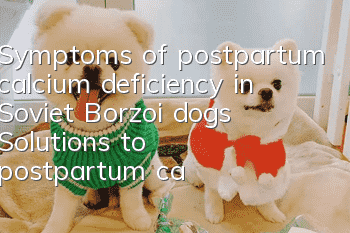Symptoms of postpartum calcium deficiency in Soviet Borzoi dogs Solutions to postpartum calcium deficiency in Soviet Borzoi dogs

Symptoms of postpartum calcium deficiency in Soviet Wolfhounds:
Most of them appear around 15 days after delivery, usually without any signs and suddenly onset. The affected dog showed restlessness, excitement, a rigid gait, sometimes howling, unsteady standing, tonic twitching of muscles all over the body, foaming at the mouth, difficulty breathing, visual cyanosis of the mucous membrane, and an increase in body temperature above 40°C, which could lead to death in severe cases. .
Postpartum calcium deficiency in Russian Borzoi bitches occurs around 15 to 20 days after birth. This is mainly due to the fact that during pregnancy, as the fetus develops, the mother’s calcium is used extensively by the fetus during bone formation. . During the lactation stage, a large amount of calcium in the blood enters the mother's milk, which greatly exceeds the mother's ability to compensate, thereby increasing muscle excitability and causing systemic muscle spasm symptoms, which in turn leads to the onset of disease in the female dog.
Solutions to postpartum calcium deficiency in Soviet Wolfhounds:
Diet is an essential thing every day. If you want to prevent calcium deficiency in dogs, you must start with their daily diet. In addition to feeding your dog a single dog food, you must also pay attention to the dog’s reasonable diet. The calcium content in dog food is very small, and some even have no calcium content. You can give your dog some foods with higher calcium content, such as dried shrimps and soy products, and you can also give your dog more vegetables and fruits to supplement vitamins. When giving calcium supplements to dogs, pay attention to vitamin intake so that dogs can better absorb calcium.
In the first few days, feeding should be based on the principle of "eat less and more meals". Generally, broth, porridge, milk and other foods that are easy to digest and absorb are the main ones. It can be fed 3 to 4 times a day. In addition to appropriately increasing concentrates and vegetables, more meat, liver, bone soup, broth, eggs and milk should be fed to supplement calcium for the female dog.
In order to achieve a better purpose of calcium supplementation, you can also choose professional pet calcium supplement products. In terms of effectiveness, liquid calcium is now generally recognized, followed by calcium powder, and finally calcium tablets.
In addition, giving your dog some sunshine can also help your dog absorb calcium better. However, you should not bask in the sun for too long to prevent your dog from getting sunburned or suffering from heatstroke.
- How long does it take for dogs to be dewormed before all the worms are killed?
- Signs of depression in dogs, come and see if your dog has it
- What should you do when faced with "fungi + mites + inflammation"?
- Select competition-grade Husky puppies based on bone proportions
- Illustration of the correct ways and precautions to greet your dog
- Dogs have dandruff and hair loss
- What to do if Teddy can’t digest dog food
- Will the ancient shepherd dog recognize its owner?
- Does Corgi recognize its owner?
- Can a dog recover after being hit by a car and unable to stand on its hind legs?



